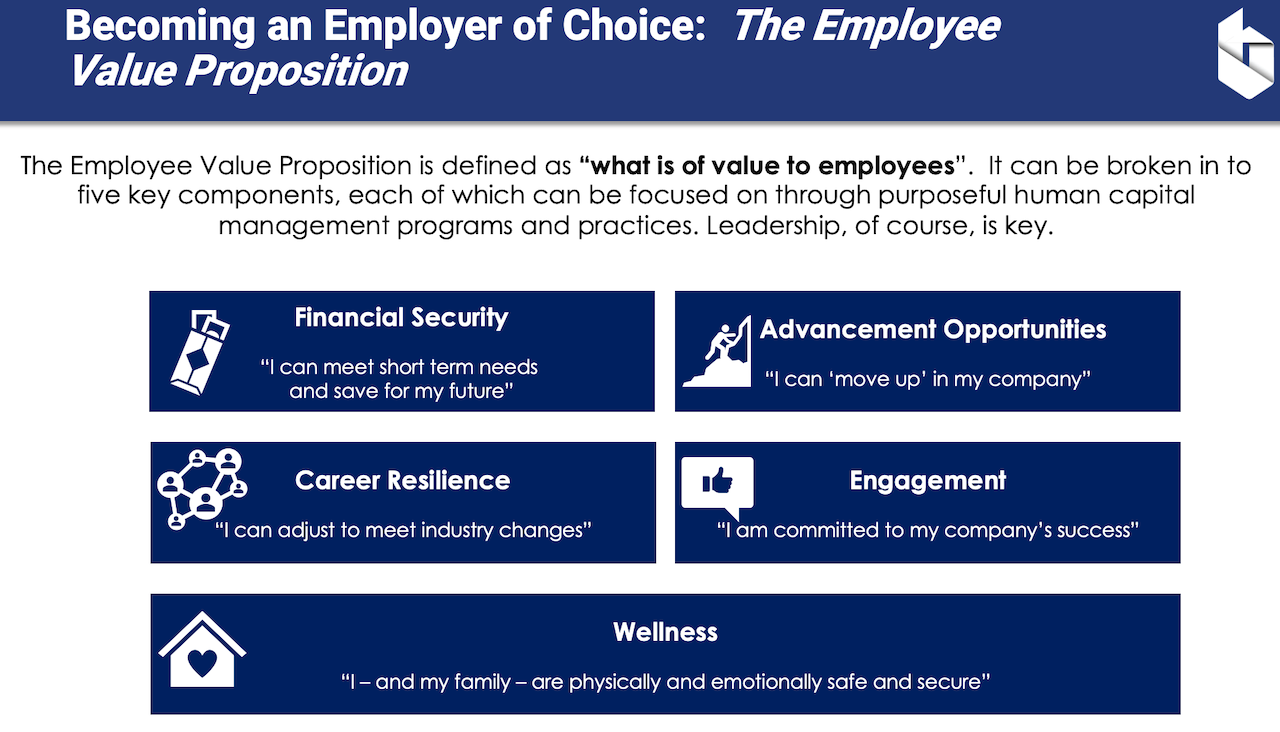Leadership
Two Fallacies Of Construction's Labor Capacity Crisis, And A Real-World Fix
Few doubt the fact that unstable access to skilled and adaptive frontline workers, managers, and strategists right up the value chain stands, arguably, as the No. 1 risk to business plans, industry sector capability, and economic impact in residential investment.

Two common fallacies ride along with residential construction and real estate's severe and worsening labor capacity, building talent, and construction management crisis:
- Fallacy #1: The crisis' causes and potential solutions are external, meaning individual firms and the industry community can not solve the problem.
- Fallacy #2: Running a successful, profitable business and investing in people who work for it and partner with it run at odds with one another.
Crisis it is, and few doubt the fact that unstable access to skilled and adaptive frontline workers, managers, and strategists right up the value chain stands, arguably, as the No. 1 risk to business plans, industry sector capability, and economic impact in residential investment.
Too many, however, consider the challenge an abstract and unsolvable one that they have no say or sway in changing the outcome. Fact is, the fixes are an inside job, not an external force that somehow tilts the talent playing field suddenly in construction and real estate's favor.
We're going to address the two fallacies of the construction talent and frontline worker shortage head on at the upcoming PCBC Conference in Anaheim, May 24 and 25. What's more, our workshop session "Enhancing Employee Value Proposition," from 1 pm to 2:45 pm on May 24, will approach company and construction partner talent challenges – recruitment, retention, engagement – in a real-world, on the ground tactical work session.
Our workshop will serve as a team leader's strategic and operational guide to investing in people for success in the construction and manufacturing industries," says Branka Minic, ceo of Building Talent Foundation and a session panelist. "To attract and retain top talent, companies need to reframe investing in their people. Our session will discuss the benefits of investing in employee training, wellness, and development programs, and provide specific examples of companies in the construction and manufacturing industries that have seen success as a result of these investments. We will also explore the opinions of Gen Z job seekers and provide creative ways for construction and manufacturing companies to attract them to hiring events."
An "Employee Value Proposition" lens gives company owners and managers a framework and a set of tools and solutions to appreciate returns on team member experience commitment and investment, says co-panelist Stuart Kliman, who is partner and head of Center of Excellence at Building Industry Partners.
Most companies understand the value of a strong brand and value proposition as a means to market their services to potential customers," says Kliman. "But this kind of strategic thinking is equally important, if not more so, for attracting employees. The homebuilding industry is more reliant on a strong, sustainable workforce than nearly any other industry. Construction jobs cannot be outsourced overseas or automated. The quality, speed and accuracy of the services companies in this sector provide are directly tied to their employees. Today, it’s more important than ever for homebuilding companies to be able to attract the best talent, train them, and keep them."

Here's some topline evidence on the real-world business and financial return on investing in employee training, wellness, and other programs that address those five bedrock value areas BIP's Kliman identifies:
- Improved retention rates: According to a study by the Society for Human Resource Management, companies with strong training and development programs have a 24% higher retention rate than those that don't invest in employee development.
- Increased productivity: Research by Gallup shows that engaged employees are 21% more productive than their disengaged peers. Furthermore, companies with a strong culture of wellness and work-life balance have been shown to have higher levels of employee engagement and productivity.
- Stronger brand reputation: According to a survey by Glassdoor, 77% of job seekers consider a company's culture before applying for a job, and 84% say that the reputation of a company as an employer is important. By investing in their employees and creating a positive workplace culture, companies can attract top talent and build a strong brand reputation.
- Improved financial performance: Studies show that companies that invest in employee training and development see a 24% higher profit margin than those that don't. Furthermore, companies with high levels of employee engagement have been shown to outperform their peers in terms of financial performance.
- Improved customer satisfaction: Companies that invest in their employees often have more engaged and motivated staff, which can translate into improved customer service and higher customer satisfaction.
- Increased innovation: Employee training and development programs can help foster a culture of innovation, with employees who are better equipped to generate new ideas and problem-solve creatively.
- Enhanced safety: Safety training programs can help reduce workplace accidents and injuries, which can have significant financial and reputational costs for businesses.
- Compliance with regulations: Many industries have regulations in place requiring employee training and development, such as safety training or compliance training. By investing in these programs, businesses can ensure they are in compliance with regulatory requirements.
- Improved teamwork and collaboration: Employee development programs, such as team-building exercises or leadership training, can help improve teamwork and collaboration within the organization, leading to improved communication and more effective decision-making.
Adds BTF's Branka Minic, the opinion of young people, particularly Gen Z, on training, wellness, and other employee programs is critical business factor.
Gen Z is the youngest generation in the workforce and is known for prioritizing personal and professional development, work-life balance, and a positive work environment," Minic says. "According to a survey by Deloitte, 80% of Gen Z employees said that opportunities for career growth and development are important when choosing an employer. Furthermore, 75% said that work-life balance is important, and 61% said that a positive work environment is important."
Minic cites another survey by LinkedIn that found that the top factors that attract Gen Z to a company are opportunities for career growth and development, a positive work environment, and a good work-life balance. In fact, Gen Z employees were more likely than any other generation to value opportunities for learning and development when choosing a job.
We'll explore specific examples of companies that have invested in their employees – and how they do this sustainably -- and as a result had better business results, better retention of employees and stronger brand," says BTF's Branka Minic.
This is not about fluff, nor soft skills, nor anything abstract or foreign to any successful business person working in the homebuilding, manufacturing, or distribution channel as an operator.
A long-time friend and widely respected top 20-ranked homebuilding company ceo writes this week about homebuilding and related industry business failures across a four-decade-plus span of direct experience.
Failed homebuilders, land developers, etc. typically blame their capital partners (banks/equity) for the failure of the business, rather than looking in the mirror. It is like the old football excuse: 'We didn’t lose, we just ran out of time.' ... Bottom line [when a business doesn't make it] its leaders did not figure out how to be profitable; real net income, earnings per share profits. Lots of homebuilders with same issues. They bounce along making minimal margins, always a year or two away from breaking through, but never get it done. Business is really hard, and capital has limited patience."
And that's what gets him up and fires him up about doing the work he does each day, he says, adding the big takeaway:
The lesson is you need to get profitable quickly, prove and refine the business model, and then scale that model."
That axiom goes for existing businesses as well as new ones. Further, the raw material ingredients – executives and owners always and forever cite when they come down to the brass tacks of what they need to profitably serve homebuying and renting customers – are land, money, and [talented] people.
Success means – and has always meant -- having access to these three most basic resources; failure means not having that access. As fundamentals, they're a kind of tyranny suited to the character, resolve, and day-to-day ingenuity of so many of the homebuilding community's owners and leaders we've known through the years. They live with it and even embrace these rules, considering them non-negotiables.
The people part of the residential construction and real estate resources trifecta – a known business risk for more than a decade now – rates as a vicious-circle challenge of attrition, capability constraint, and lost productivity that exposes both the individual businesses and the entire residential real estate and construction sector's power to work as an economic growth engine for GDP.
Here's an opportunity to break out of that vicious circle. See you in Anaheim in just a couple of weeks.
MORE IN Leadership
10 Bold Ideas Tackling Housing Affordability And Access Now
From AI to hempcrete, these 10 ideas show how innovation in design, finance, and policy can open the door to housing affordability.
Sumitomo Forestry Sharpens U.S. Focus With DRB Move
Strategic clarity replaces portfolio sprawl as Sumitomo bets big on U.S. scale and integration.
Homebuilders and Insurance: A New-Reality Cost To Stay Ahead
Exclusive insights from Westwood Insurance Agency’s Alan Umaly and MSI’s Naimish Patel reveal why homebuilders must rethink insurance, resilience, and risk management—or risk losing buyers in an increasingly volatile market.
